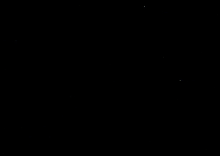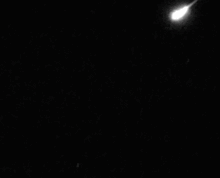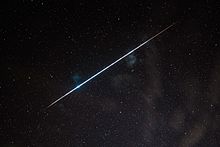meteor

( Variant of the recording in ten times slow motion. )

As meteor (singular of Meteor , fachsprachlich the Meteor ) is the illumination of shooting stars called when (from about 0.1 mm size) as small rock or dust particles in the upper atmosphere burn, and the lighting up of larger bodies ( balls of fire ). Sometimes other luminous and weather phenomena in the atmosphere and near the earth's surface are also referred to as meteors.
The astronomical science of meteors in the narrower sense is meteorology . Today, meteors are primarily the glowing phenomena of falling stars ; when the brightness is higher, one speaks of fireballs or bolides . They are generated by small meteoroids that penetrate the earth's atmosphere and ionize the air particles when they burn up ( recombination lights ). The few bodies that fall to the surface of the earth are called meteorites .
The remnants of the glow and the finest, not freely visible meteors ( micrometeorites ) then result in the extraterrestrial aerosols . The estimates of the constantly trickling meteor dust range from a few hundred to 5,000 tons per day.
Most of the shooting stars can almost always be seen in the second half of the night, because then the observer is on the front of the earth's movement around the sun. This becomes particularly clear when observing swarms of meteorites such as the Perseids in August or the Geminids in December.
Origin of the word
The word meteor comes from the ancient Greek μετέωρος metéōros , German 'floating in the air' , where it originally also included phenomena in the sky and thus some celestial bodies ( neuter plural μετέωρα meaning “celestial phenomena”). Many such phenomena were already described in antiquity, for example by Aristotle in his work Meteorology . Today's meteorology and climatology deals with the observation and description of weather events in the atmosphere and only marginally with the associated luminous phenomena. Today, the term in this specialist field primarily includes atmospheric optics and atmospheric physics of suspended particles ( aerosols and atmospheric water).
Types of meteors
Apart from the above-mentioned meteoroids , which cause shooting stars to light up in the high atmosphere, the German Weather Service , for example, distinguishes the following categories of meteors in the atmosphere, which may be visible:
- Electrometeors related to charged particles
- Hydrometeors in connection with water in the physical states solid and liquid
- Lithometeors related to airborne particles that are not composed of water
- Photometeors caused by reflection , refraction , diffraction or interference of light .
Concomitant effects of earthquakes are not counted as meteors, although they can cause earthquake lights or thunder noises in the atmosphere. Even variable light phenomena outside the earth, such as comets , variable stars or novae , are not included.
The meteors are mostly natural phenomena , but some are of anthropogenic origin, for example contrails from airplanes, smoke from chimneys, industrial snow or iridium flares , which are caused by the reflection of solar radiation on satellites .
Meteoroids
Meteoroids are mostly grains of dust, small metal or rock grains from interplanetary space, of which around 10 billion per day fall from space with a total mass of 10 to 150 tons into the earth's atmosphere . Because of their enormous speed of around 11.2 to 72 km / s - depending on the angle of incidence to the earth's orbital motion - most of them evaporate at a height of around 80 kilometers through air friction; in doing so, they ionize the air molecules, which causes bright traces of light.
Shooting stars and fireballs

The majority of the meteors are of interplanetary origin; very few reach Earth from interstellar space . Just as the earth and the other planets orbit the sun , so do meteor streams orbiting the sun.
In addition to individually occurring meteors ( sporadic meteors ) there are meteor streams . These occur when the earth crosses the trajectory of a comet . Since the observer has the impression that the tracks of all these meteors meet at one point if they are extended in the opposite direction to the direction of movement, the meteor streams are named after the constellation in which this radiant lies.
Well-known meteor streams are the Quadrantids in January, the Perseids in July and August, the Leonids in November and the Geminids in December. The days between August 8 and 14, when the “Perseids” from the constellation Perseus “rain” on earth, are particularly rich in shooting stars .
Even artificial earth satellites and rocket parts ( space junk ) evoke during re-entry into Earth's atmosphere meteoroids luminous phenomena. However, they are much slower, which is how you can distinguish them from meteors.
Size and division
In the vernacular, small meteors are also called shooting stars (see Schnuppe ). Their original objects have a diameter of around 1 mm. Larger objects (> 10 mm) are called bolides , fireballs or fireballs .
Telescopic meteors are shooting stars that are no longer freely visible, but instead move randomly through the field of vision when observing telescopes. As radar meteors that are referred to whose ionisation with radars also at daytime sky can be observed.
| designation | Diameter of the original body |
Dimensions | Total mass of all objects that reach the earth each day |
|---|---|---|---|
| Fireballs, bolides | larger than 10 mm | more than 2 g | 1 t |
| Shooting stars (−4 mag to +6 mag ) |
1 mm to 10 mm | 2 mg to 2 g | 5 t |
| Telescopic meteors | 0.1 mm to 1 mm | 0.002 mg to 2 mg | 20 t |
| Micrometeors | smaller than 0.1 mm | less than 0.002 mg | up to 125 t |
Most meteor phenomena last only a fraction of a second and are produced by particles that are less than a millimeter in size and generally hit the Earth's atmosphere at 30 to 70 kilometers per second. They burn up completely. Meteoroids the size of a grain of rice produce impressive luminous phenomena lasting more than a second.
On the other hand, larger objects with a mass of at least a few kilograms are much rarer, which may not burn up completely, strike the earth's surface as a meteorite and, depending on their size, can leave considerable traces there (e.g. the Nördlinger Ries , the Barringer crater and the crater in Yucatán ). This is particularly the case with iron meteorites. Stone meteoroids mostly disintegrate (counter-example Carancas ), even with larger dimensions, into a swarm of parts and can hit the ground as a meteor shower (see 2008 TC 3 ). Even if solid constituents do not reach the surface of the earth, they can still generate a considerable pressure wave (see Tunguska event , Meteor of Chelyabinsk ).
Effects
The glowing effect that occurs is only partially caused by the burning up of the particle itself, because meteors glow at a height of over 100 kilometers. Due to air friction and evaporating material, a plasma trace forms behind the body , which glows through the radiant recombination of excited electrons of the air atoms. The tracks can therefore still shine after the meteoroid has already burned up. They can be detected for minutes on the basis of the reflection of radio waves on the conductive plasma ( meteor scatter ). The area of the excited particles is only a few millimeters wide. However, since the particles are in the excited state for about 0.7 seconds, they can move up to 300 meters from the location of the collision, creating a more or less wide tracer. The lighting effects caused by meteors are systematically observed and recorded by the European fireball network .
In addition to the visible appearance, noise can sometimes also be heard in larger meteors - for example as a distant rumble of thunder ( but only after a few minutes because of the low speed of sound ) - but sometimes after a very short time. The latter phenomenon has often been taken to be imaginary, because you usually hear a sort of hissing sound with every nearby trail of light (like fireworks ). Today it is assumed that the noises can be generated by low-frequency radio waves , which arise from turbulence in the plasma caused by the meteor together with the earth's magnetic field (see magnetohydrodynamics ).
Meteors are slowed down almost independently of their entry speed by the increasing air resistance, as can be seen in the diagram on the right. A higher mass with the same density only shifts all graphs to the left.
Brightness development
If a meteor got very bright, it doesn't necessarily mean the intruder was quite large. Only the ablation of the penetrating material per unit of time determines the brightness of the meteor. If a lot of material is suddenly removed from the meteoroid per second, the meteor becomes significantly brighter, but the intruder now also loses mass much faster. Precisely for this reason, it often happens that meteoroids made of soft material (for example cometary objects) explode in a spectacular bolide in a very short time and other hard materials (for example stony objects) are consumed in a much weaker ball of fire. Meteors begin weakly and increase in their luminosity. The end of the light phenomenon usually occurs suddenly and means a rapid decrease in brightness. The apparent brightness can fluctuate a lot.
Meteor rate
The event of a sporadic meteor can be observed an average of four times an hour. However, meteor events themselves are more likely to light up on the front of the earth's atmosphere. This is the time between midnight and noon every day, whereby the faint meteors can only be seen at night and then preferably far away from artificial light sources. The moonlight can also be very disturbing. But there are times in the year when the meteor rate is above average. A meteor shower is a kind of “cloud” or “tube” of meteoroid particles on approximately parallel paths around the sun. Pass through such an area during the passage of the earth heaped on meteors from radians radiate. A meteor shower is named after the constellation in which the radian is located. Such a current is created when a comet loses many small particles of frozen gases and dust during its journey around the sun. A meteor shower is a very strong activity of a meteor shower when the rate has to be estimated in thousands per hour.
Radio meteors
Even if optical observations of meteors are dependent on the darkness of the night, meteors can also be detected during the day with the help of radio methods. This takes advantage of the fact that the plasma tube generated by the meteorite reflects radio waves. With this method, even the smallest meteorites down to 1 μg can be recorded.
Meteor research
Research into meteors has a long tradition in astronomy. The orbit determination made possible by open-eyed observation of the flight path or by special meteor cameras gives an insight into the origin of these small bodies, which practically all come from the solar system . Most of them are remnants of earlier, resolved comets or through collisions of other small bodies . The meteorites that occasionally fall on the surface of the earth are important witnesses to the early days of the solar system.
The observed course of brightness of the luminous phenomenon and possible spectroscopy allow conclusions to be drawn about the type of material and its strength. Up until around 1950, analyzing the glow of meteors was also one of the few ways to investigate the density and composition of the high atmosphere . From the estimation of the so-called dark flight (flight path after the luminous phenomenon has ceased), fragments that have fallen to the earth can sometimes be found, which, as iron or stone meteorites, give some information about the formation of the early protoplanets .
Meteor research has been carried out since around the middle of the 19th century and also gave rise to the establishment of some astro associations and the astronomical offices in Transylvania and Vienna. Around 1870, the Milanese astronomer Giovanni Schiaparelli (who was best known for his discovery of the Martian channels ) succeeded in proving that the meteor streams go back to the decay of comets.
Known meteor streams
| Name of the stream | Period | maximum | ZHR |
|---|---|---|---|
| Quadrantids | Dec 28th - Jan 12th | January 3rd | 120 |
| Lyrids | Apr 16 - Apr 25 | April 22 | 30th |
| Perseids | Jul 17 - Aug 24 | 12. August | 100 |
| Taurids | Sep 15 - Nov. 25 | November 10th | variable |
| Leonids | Nov 6th - Nov 30th | November 17th | 15th |
| Geminids | Dec 4 - Dec 17 | December 14th | 120 |
regional customs
In the popular superstition of many countries, someone who happens to see a shooting star in the night sky has a wish that is supposed to come true. As soon as you have seen the shooting star, you should close your eyes and make a wish. It is important that you are the only one who has seen this falling star and that you do not tell anyone else about your wish, otherwise it will not come true.
In Silesia , Upper Palatinate and Bohemia there was a belief that treasure could be found where a shooting star fell to the ground. This motif can also be found in the fairy tale Die Sterntaler .
See also
literature
- Carl Jacob Christoph Joseph Diruff: Ideas for explaining the nature of the meteor or air stones . Dieterich, Göttingen 1805 ( digitized version ).
- Heinrich Müller: Father Beresfort's natural history conversations with his sons about the wonders, the splendor and the uses of the meteors. Instructions for viewing and knowing great, powerful, friendly and delightful natural phenomena . Krappe, Leipzig 1837 ( digitized version ).
- Cuno Hoffmeister : Meteors, their cosmic and earthly relationships . Academic Publishing Company, Leipzig 1937.
- Cuno Hoffmeister: Meteor Streams . JA Barth Verlag, Leipzig 1948.
- Jürgen Rendtel: Shooting stars . Urania Verlag 1991, ISBN 3-332-00399-2
- Robert Hawkes, Ingrid Mann, Peter Brown: Modern Meteor Science. An Interdisciplinary View . Berlin 2005, ISBN 1-4020-4374-0 .
- Edmond Murad, Iwan P. Williams: Meteors in the earth's atmosphere - meteoroids and cosmic dust and their interactions with the earth's upper atmosphere. Cambridge Univ. Press, Cambridge 2002, ISBN 0-521-80431-0 .
- O. Richard Norton, Lawrence A. Chitwood: Field guide to meteors and meteorites. Springer, London 2008, ISBN 978-1-84800-156-5 .
- Jürgen Rendtel, Rainer Arlt: Meteors . Oculum-Verlag 2012, ISBN 978-3-938469-53-8 .
- Emil Adolf Roßmaessler: The shooting stars nights of November 12th and 13th . In: The Gazebo . Issue 45, 1853, pp. 492–493 ( full text [ Wikisource ] - From the schoolmaster emerit. Johannes Frisch to his former student. 15th letter).
Web links
- Shooting star or meteor in the astrolexicon
- Shooting stars highlights, the meteor shower calendar
- Fireball over Berlin
- Meteors . Working group meteors e. V.
- Chr. Pinter: Flashing cometary dirt - On the role of the Perseids and Leonids in the history of research . ( Memento from April 19, 2005 in the Internet Archive )
- Meteor Echoes. Spaceweather radio
- International Meteor Organization
Individual evidence
- ↑ Meteor. In: Digital dictionary of the German language . Retrieved August 14, 2017
- ^ Wilhelm Gemoll : Greek-German school and hand dictionary . G. Freytag Verlag / Hölder-Pichler-Tempsky, Munich / Vienna 1965.
- ^ Meteorology by Aristotle ; on classics.mit.edu.
- ↑ Dauna Coulter: What's Hitting Earth? NASA, March 1, 2013, accessed July 15, 2016 .
- ↑ Tony Phillips: The Sky is Falling. NASA, April 28, 2006, accessed July 15, 2016 .
- ↑ Meteor. In: National Geographic Encyclopedia. National Geographic Society, accessed July 15, 2016 .
- ↑ a b Kelly Beatty: How much space debris falls into Earth's atmosphere every year? National Geographic Society, July 21, 2006, accessed July 15, 2016 . Note: 40,000 metric tons per year / 365 ≈ 109 metric tons per day
- ^ A b Arnold Hanslmeier: Introduction to Astronomy and Astrophysics . 2nd Edition. Springer Spectrum, 2007, ISBN 978-3-8274-1846-3 , pp. 198 .
- ↑ Meteors nhm-wien.ac.at; Meteor-Radar, livestream from NHMWien @youtube; accessed on July 1, 2018.
- ↑ The trail of the fireballs. On: Wissenschaft.de from September 13, 2007.
- ^ Richard-Heinrich Giese : Introduction to Astronomy. Scientific Book Society, Darmstadt 1981, ISBN 3-534-06713-4 .
- ↑ ZHR - Abbreviation for Zenithal Hourly Rate . It indicates how many meteors per hour an observer would see with absolutely clear and dark skies if the radian (from which the meteor shower comes) were at the zenith (i.e. vertically above the observer).
- ↑ Andrea Schorsch: Long cultivated superstition: Why shooting stars bring luck n-tv.de, August 12, 2013, accessed September 9, 2016.
- ↑ Article Sternschnuppe, Concise Dictionary of German Superstition , p. 23097


